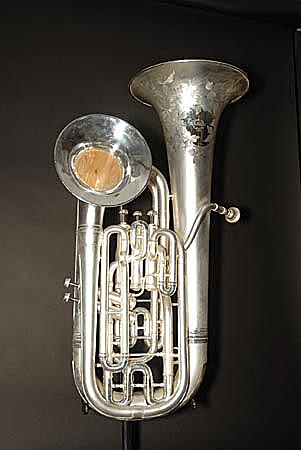
Owner: HWMC
Catalog # CL-AELV-172
Baritones / Euphoniums
Euphonium: ‘C G Conn’ Double Bell (B)
Elkhart, Indiana, United States
C. G. Conn
Silver plated
ca. 1930’s
Height: 31.5 inches
Wind Instruments – Brasswinds – Baritones / Euphoniums
The double bell euphonium is an instrument based on the euphonium. It began to be produced in the United States in the 1880s, with the Conn brand being the forerunner. John Philip Sousa introduced them to his band around 1889, and other American bands would follow the example. There are two main versions, those that have both removable and directional bells and the version with the fixed euphonium bell (upwards) and the directional trombone bell (seen here). Their production stopped during the 1960s, after the US military bands officially suspended their use in 1956, due to lack of use.
According to Oscar Abella website: Oscar Abella | Tuba & period instruments. The double bell euphoniums are probably inspired by the Milanese Duplex of Giuseppe Pelitti. Pelitti actually presented the first prototype in 1847 in a contest organized by the Instituto Lombardo di Szienze, Lettere e Arti, and then a whole family of those in the 1851 edition: a Flugelhorn-Cornet, a Trumpet-Alto Horn in Eb, a Bombardino-Valve Trombone and a Bombardone-(Contra)Bass trombone in F. Then, Adolphe Sax copied this idea, and in the Universal Exhibition of Paris of 1855, he won the first prize for the invention of the Trumpet-Alto Horn in Eb, even ahead of Pelitti, who himself was there, through a series of dirty tricks and games. Later Pelitti would invent versions with 3 bells and even versions with a bell inside the other.
This C G Conn double bell 5 valve euphonium was possibly made in 193o’s in Elkhart, Indiana. The fifth valve is used to control the extra bell while the fourth valve is used for the low pedal notes.
Resource: Oscar Abella | Instruments
